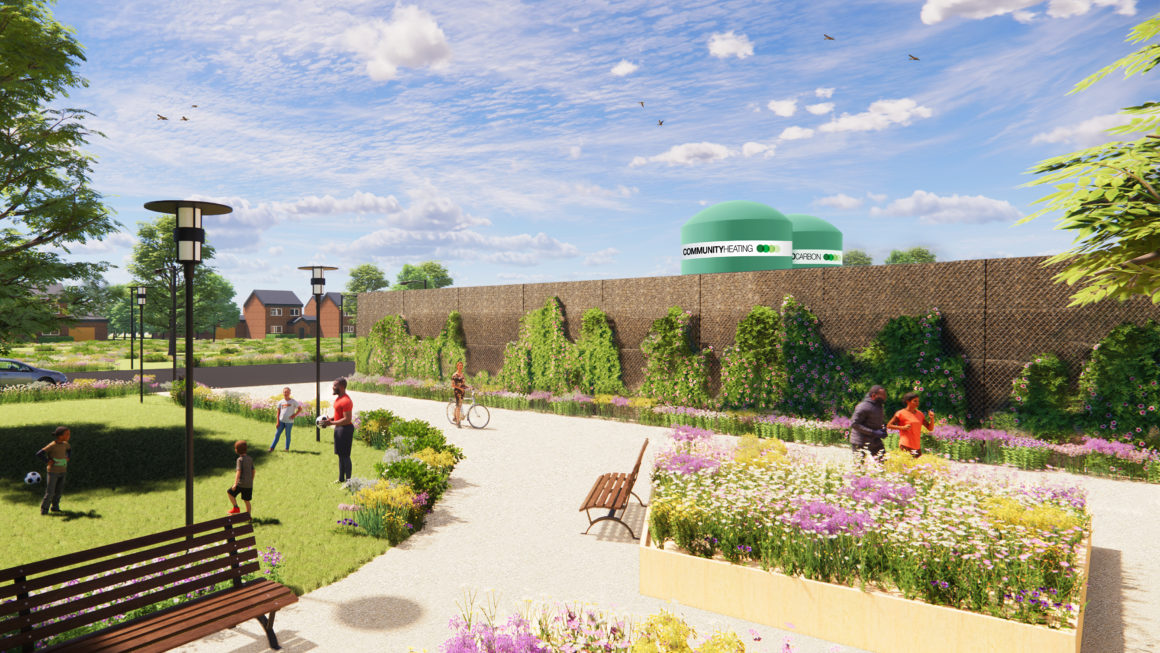GTC reveals a low-carbon heating solution to replace the use of gas for new homes

GTC has developed a heat network solution for traditional, new-build, low-rise developments. Hot water is produced centrally in a Community Heat Hub, using large-scale Heat Pumps powered by grid electricity.
This solution reduces carbon emissions by 75-80% based on current building regulations. It should comfortably meet the anticipated carbon emissions requirements of the 2025 Future Homes Standard (FHS). Thanks to the increase in renewable generation from wind and solar, the grid is moving towards net zero carbon for 2050.The Community Heat Hub solution automatically will become net zero when the grid gets to this point in 2050.
From the Hub, hot water is fed to all individual homes through a highly insulated plastic-pipe heat network, to provide instantaneous heating and hot water. There is a thermal water storage tank in the Community Heat Hub, replenished when wholesale electricity costs are lower. This store reduces peak demand on the grid, lessening the need for reinforcement. Back-up electric boilers ensure a resilient supply of hot water.
The result is that homeowners have a simple, reliable supply of heat and hot water directly into the home from a central source on the development, owned and maintained by a specialist company – a similar experience to using gas.
Heat networks were previously only available using steel pipes, but regulations now allow lower operating temperatures so insulated plastic pipes become viable. This makes heat networks cost efficient on low-density developments.
COO John Marsh explains: “We provide utility infrastructure for new housing sites, so we are delighted to offer this alternative to gas. Our business owns and operates heat networks across London. We have built on this experience to extend heat networks to low-density sites for GTC installation. This provides a simple, competitive option for housebuilders and homeowners. It reduces carbon emission by 75-80% and becomes zero-carbon when the grid gets to zero carbon.”
“This is a viable, sustainable, cost-effective solution, which is available now.”
Business and Energy Minister Lord Callanan said: “Heat networks using heat pumps powered by clean, cheaper renewable energy generated here in the UK are cutting emissions and helping us take charge of our energy security.
“Low carbon heat networks can help households and businesses move away from expensive fossil fuels. Systems like this one developed by GTC will accelerate the rollout of the technologies we need to achieve this.”
Housebuilders onboard
One of the UK’s largest housebuilders, Taylor Wimpey, is partnering GTC in a pilot project to deliver heat via a Community Heat Hub onto a new low-density site, currently in the planning stage. This will replace the use of gas. GTC is rolling out this solution to other major housebuilders and landowners.
Stephen Andrew, Group Technical Director at Taylor Wimpey comments: “As we move towards the Future Homes Standard (FHS) in 2025 and the introduction of zero carbon heating with no natural gas, the network heat pump offers an innovative solution to meet FHS. Whilst this was previously used in dense high rise apartment schemes, this innovative approach offers the opportunity to provide community heating to other types of residential developments, including family homes. We are pleased to be trialling the GTC community heat network at Chilton Woods, Sudbury.”
A planning application for the Community Heat Hub at the Chilton Woods development has been submitted this month.
To find out more about our innovative solution take a look at our GTC Community Heat Hub Brochure.